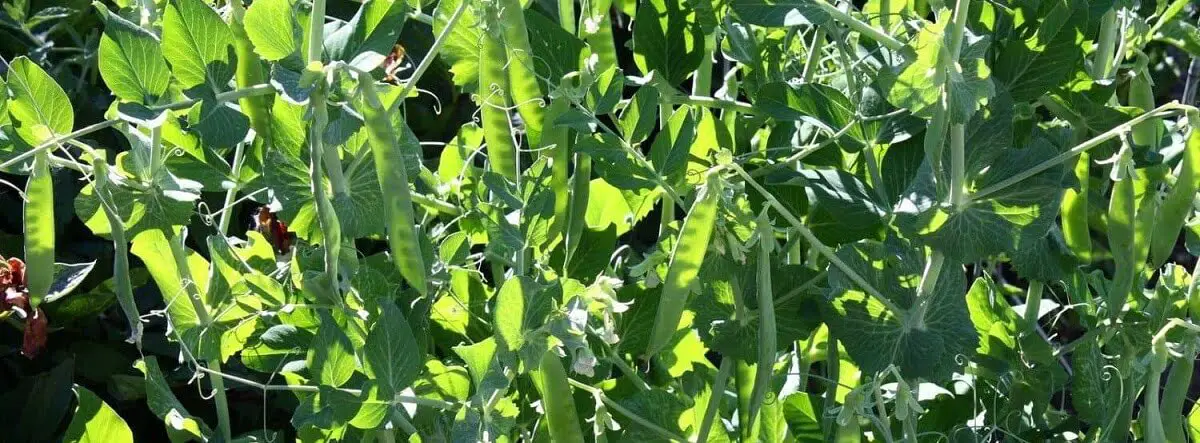Planting Green Arrow Peas Guide What You Need To Know
Green Arrow Peas Seed to Harvest

Green arrow peas are a shelling pea variety. So we must let the pods fully mature and remove the peas from the shell.
Unlike snap peas, green arrow peas shells do not get eaten, and we need to break the pods open and collect the peas before we eat them.
The plant is easy to grow and reaches full maturity in just over 2 months from the seedling stage. They are tender and sweet tasting, and we can eat them fresh, freeze them, or use them in cooking.
The pods will grow to around 5 inches (13 cm.) in length, with 10 to 11 peas inside. While the plant only reaches about 24 to 28 inches (61-71 cm.) tall, it is a vine variety, not a bush.
We can plant them in the early spring as one of our first crops or in late spring, giving us a late fall crop. They will survive through minor frosts but do not do well in high heat.
It is important to get them planted early when growing them in the spring. Since hot summer temperatures will prevent them from setting pods when it gets around 80 degrees F.
If your garden has issues with fusarium wilt or powdery mildew. This plant is an excellent choice since it is resistant to both.
Green Arrow Peas Growth Stages
- Germination
- Seminal Taprooted Stage
- Fragmentation of the Taprooted Plant
- Clonal Growth Stage
- Flowering
- Fruiting
Are Green Arrow Peas an Annual or Perennial
Green arrow peas are a winter annual.
So we will need to plant a new batch in our gardens every year to keep it around.
Green Arrow Peas Scientific Name
The technical name for green arrow peas is Pisum sativum meaning green arrow.
Green Arrow Peas Soil Type
We want to plant the seeds in free-draining soil, and growing in an overly compacted soil type will increase the chances of the plant developing root rot.
Our soil should be in a pH range between 6.0-7.5 to make sure we get proper growth.
Using mulch helps protect our soil from getting too hot going into summer and reduces moisture buildup around our plant's roots.
Planting Green Arrow Peas
We want to wait until the chance of frost has passed before we plant our peas. We want the soil dry enough with minimal clumping, which will happen for most of us in early spring.
They require minimal soil prep, and all we need to do is take a garden rake to break up the top of our soil and loosen it up.
We will sow our seeds 1 to 1 1/2 inches (2.5 to 3.8 cm.) deep into the ground and about 1 inch apart from one another. We also will place them around 18 to 24 inches (46-60 cm.) between pairs of plants or rows.
Green Arrow Peas Sunlight Requirment
For best growth, we want to find a location with 6 to 8 hours of full sun.
They will perform ok in partial shade or where they get only 4 hours of light, but their blooming will be reduced.
Green Arrow Peas Water Requirments
These peas do not have a very high requirement for water, and the weather during fall will usually provide us with enough water.
If you notice your soil is drying out, we want to add around 1 inch of water per week.
When the weather is cool, like early spring or late fall, overwatering can cause mildew growth and may reduce our final yields.
When the plant begins to flower, we must ensure that the green arrow peas get the needed water for pods to fully develop.
How Long to Grow Green Arrow Peas
For the plant to reach full maturity, where the pods are fully developed and ready for harvest, you can expect to wait between 70 to 80 days.
The pods are ready to get picked when they reach around 5 inches (13 cm.) in length, with 10 to 11 peas inside.
Plants to Keep Away From Our Peas
Some plants will feed on similar nutrients, others will attract pests, and some are known to emit harmful elements into the soil.
- Garlic
- Onions
- Shallots
- Leeks
- Chives
- Gladioli
- Scallion
Summary
Green arrow peas make a delicious snack and are easy to grow.
They are best planted in early fall or near the end of the summer.
Having to break open the pods to collect the peas can be a little annoying. Still, you can grow these with other varieties like snap peas for some variety.
Similar Articles
Growing Chickling Vetch Peas
Planting Cowpeas
Planting Winter Peas
Planting Sugar Snap Peas